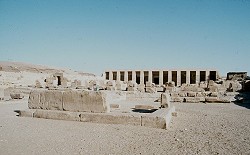
Capital of the eighth Upper Egyptian nome, also called the Thinite nome. In the area, near Umm el-Qa'ab, are the tombs of a number of kings from the Protodynastic period, including that of King Djer, later thought to be the tomb of Osiris, at least from the Middle Kingdom on. Although the original god of Abydos was Khentimentiu (the oldest temple here is dedicated to this god), he was swiftly linked to, and his cult largely usurped by that of Osiris. According to tradition, the head of this god was buried at Abydos, after he had been cut to pieces by Seth and his body parts had been scattered throughout Egypt. The nome symbol for the city symbolizes this head, wearing the Osiris crown with a double plume. Every Egyptian wanted to be buried at such a holy place; when this was not possible, then they wanted to have a cenotaph at Abydos as well as their tomb elsewhere, or at the very least erect a stela which meant they were there in name and representation. Thousands of these memorials, from roughly the Middle Kingdom on, have been found at Abydos. Many were erected at the temple of Osiris. Abydos was also a popular place of pilgrimage, not only for the living (preferably during the celebration of the mystery festivals), but also for the dead, who during their funeral - at least by means of a representation in their tomb of a boat journey - wanted to travel there. The most important constructions still visible here are some temples dating to the 19th Dynasty. Apart from a temple of Ramesses II, the sanctuary built by Sethos I is particularly well preserved, with its associated 'Osireion', assumed to be a cenotaph for the king. Its walls contain parts of the Book of the Dead and the Book of Gates, as well as a cosmological scene of the sky goddess Nut bent over the earth. All of these temples served not only the cults of the gods but also that of the dead king (who as Osiris was also a god after all). Famous, too, is the king-list carved in the temple itself, a list of 76 kings from Menes up to and including Sethos I.